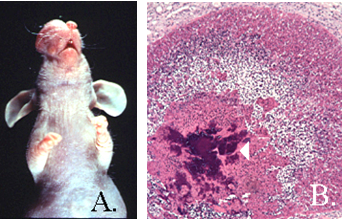Etiology: Staphylococcus aureus is a Gram-positive coccus. Staphylococcal species common to the flora of the skin and mucous membranes of mice are Staphylococcus xylosus and S. sciuri. S. aureus has not been recognized as a primary pathogen, however, several reports point to its role in outbreaks of cutaneous infections in athymic nude mice.
Incidence: The incidence of infection with Staphylococcus aureus is moderate.
Transmission: Inoculation of the bacteria into the skin apparently occurs from grooming or bite wounds. S. aureus may be transmitted from humans to mice.

Transmission: Inoculation of the bacteria into the skin apparently occurs from grooming or bite wounds. S. aureus may be transmitted from humans to mice.
Clinical signs: Although the skin usually remains intact, the resultant abscesses from grooming or bite wounds progressively enlarge and occasionally spread subcutaneously to form disfiguring lumps, primarily about the face and head. Thymic deficient nude mice develop conjunctivitis and facial abscesses from which S. aureus can be recovered in pure culture (A.).
Pathology: Histologically, characteristic lesions include multifocal to coalescing abscesses with a granular basophilic bacteria. S. aureus lesions are associated with Splendore-Hoeppli material (arrowhead, B.).
Diagnosis: Diagnosis can be made by culture of suspicious lesions.